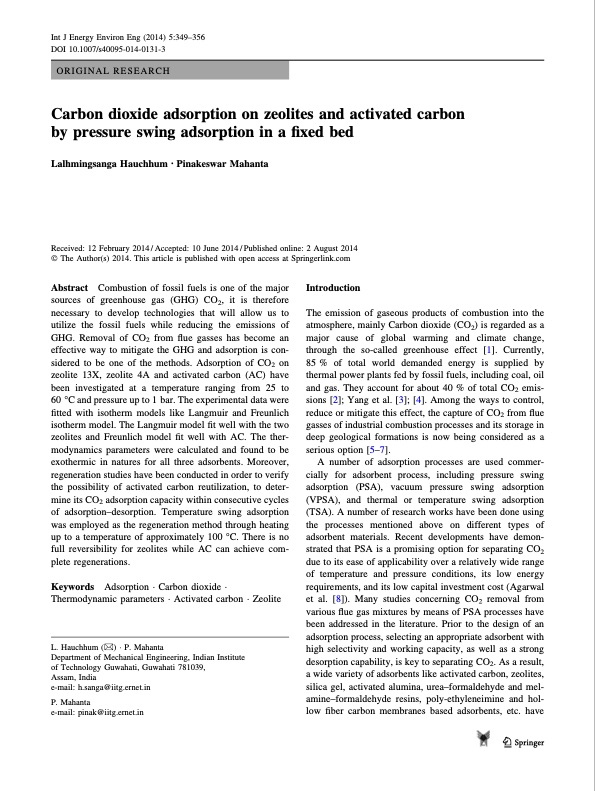
PDF Publication Title:
Text from PDF Page: 001
Int J Energy Environ Eng (2014) 5:349–356 DOI 10.1007/s40095-014-0131-3 ORIGINAL RESEARCH Carbon dioxide adsorption on zeolites and activated carbon by pressure swing adsorption in a fixed bed Lalhmingsanga Hauchhum • Pinakeswar Mahanta Received: 12 February 2014 / Accepted: 10 June 2014 / Published online: 2 August 2014 Ó The Author(s) 2014. This article is published with open access at Springerlink.com Abstract Combustion of fossil fuels is one of the major sources of greenhouse gas (GHG) CO2, it is therefore necessary to develop technologies that will allow us to utilize the fossil fuels while reducing the emissions of GHG. Removal of CO2 from flue gasses has become an effective way to mitigate the GHG and adsorption is con- sidered to be one of the methods. Adsorption of CO2 on zeolite 13X, zeolite 4A and activated carbon (AC) have been investigated at a temperature ranging from 25 to 60 °C and pressure up to 1 bar. The experimental data were fitted with isotherm models like Langmuir and Freunlich isotherm model. The Langmuir model fit well with the two zeolites and Freunlich model fit well with AC. The ther- modynamics parameters were calculated and found to be exothermic in natures for all three adsorbents. Moreover, regeneration studies have been conducted in order to verify the possibility of activated carbon reutilization, to deter- mine its CO2 adsorption capacity within consecutive cycles of adsorption–desorption. Temperature swing adsorption was employed as the regeneration method through heating up to a temperature of approximately 100 °C. There is no full reversibility for zeolites while AC can achieve com- plete regenerations. Keywords Adsorption Carbon dioxide Thermodynamic parameters Activated carbon Zeolite L. Hauchhum (&) P. Mahanta Department of Mechanical Engineering, Indian Institute of Technology Guwahati, Guwahati 781039, Assam, India e-mail: h.sanga@iitg.ernet.in P. Mahanta e-mail: pinak@iitg.ernet.in Introduction The emission of gaseous products of combustion into the atmosphere, mainly Carbon dioxide (CO2) is regarded as a major cause of global warming and climate change, through the so-called greenhouse effect [1]. Currently, 85 % of total world demanded energy is supplied by thermal power plants fed by fossil fuels, including coal, oil and gas. They account for about 40 % of total CO2 emis- sions [2]; Yang et al. [3]; [4]. Among the ways to control, reduce or mitigate this effect, the capture of CO2 from flue gasses of industrial combustion processes and its storage in deep geological formations is now being considered as a serious option [5–7]. A number of adsorption processes are used commer- cially for adsorbent process, including pressure swing adsorption (PSA), vacuum pressure swing adsorption (VPSA), and thermal or temperature swing adsorption (TSA). A number of research works have been done using the processes mentioned above on different types of adsorbent materials. Recent developments have demon- strated that PSA is a promising option for separating CO2 due to its ease of applicability over a relatively wide range of temperature and pressure conditions, its low energy requirements, and its low capital investment cost (Agarwal et al. [8]). Many studies concerning CO2 removal from various flue gas mixtures by means of PSA processes have been addressed in the literature. Prior to the design of an adsorption process, selecting an appropriate adsorbent with high selectivity and working capacity, as well as a strong desorption capability, is key to separating CO2. As a result, a wide variety of adsorbents like activated carbon, zeolites, silica gel, activated alumina, urea–formaldehyde and mel- amine–formaldehyde resins, poly-ethyleneimine and hol- low fiber carbon membranes based adsorbents, etc. have 123PDF Image | Carbon dioxide adsorption on zeolites and activated carbon by pressure swing adsorption

PDF Search Title:
Carbon dioxide adsorption on zeolites and activated carbon by pressure swing adsorptionOriginal File Name Searched:
zeolite-psa.pdfDIY PDF Search: Google It | Yahoo | Bing
CO2 Organic Rankine Cycle Experimenter Platform The supercritical CO2 phase change system is both a heat pump and organic rankine cycle which can be used for those purposes and as a supercritical extractor for advanced subcritical and supercritical extraction technology. Uses include producing nanoparticles, precious metal CO2 extraction, lithium battery recycling, and other applications... More Info
Heat Pumps CO2 ORC Heat Pump System Platform More Info
| CONTACT TEL: 608-238-6001 Email: greg@infinityturbine.com | RSS | AMP |